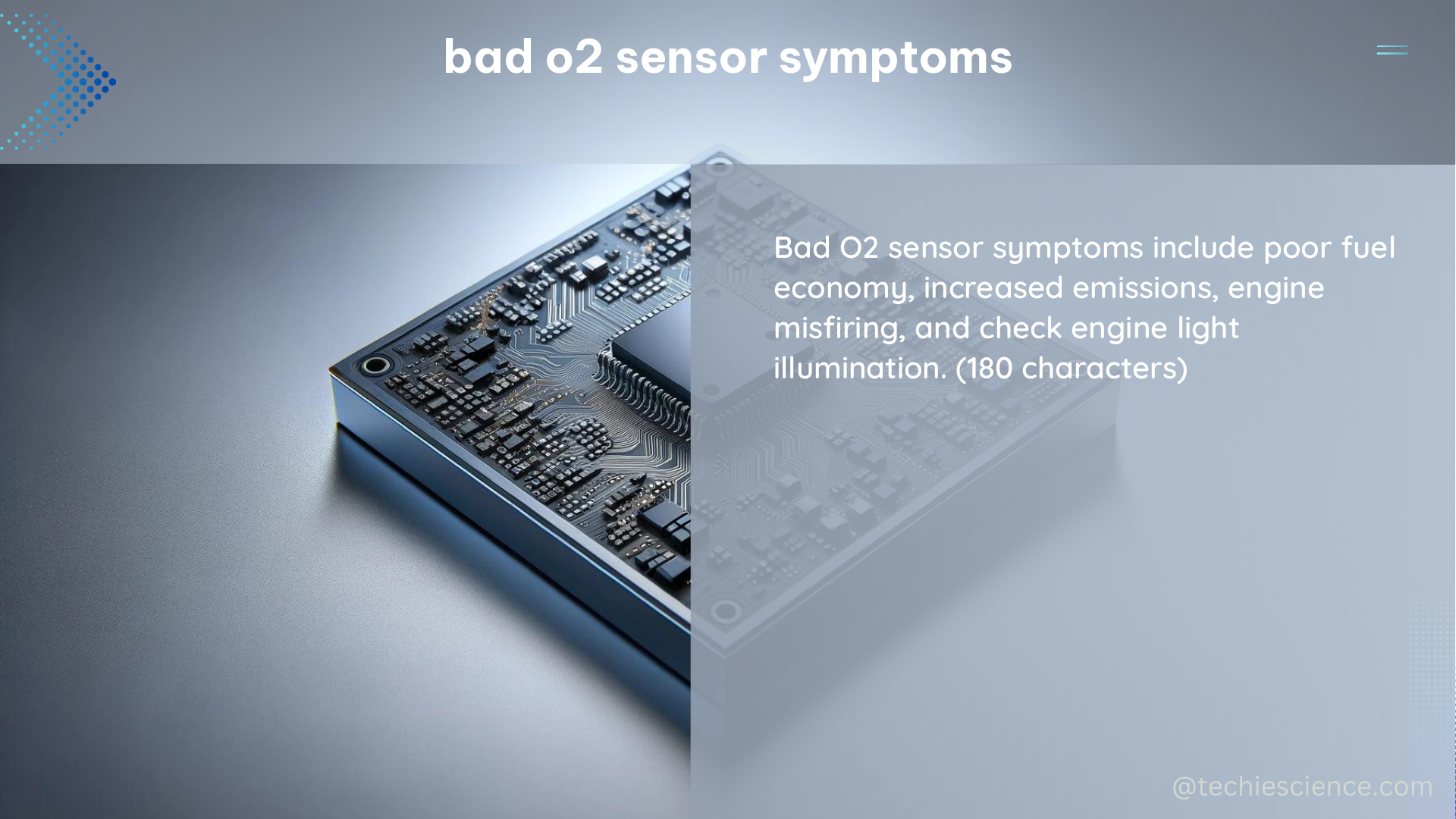The oxygen (O2) sensor, also known as the lambda sensor, is a critical component in the engine management system of modern vehicles. It measures the oxygen content in the exhaust gases and provides this information to the engine control unit (ECU), which then adjusts the air-fuel mixture accordingly. When an O2 sensor is not functioning correctly, it can lead to a variety of symptoms that can impact the vehicle’s performance, fuel efficiency, and emissions. This comprehensive guide will delve into the technical details of bad O2 sensor symptoms, providing you with the knowledge to diagnose and address these issues effectively.
Understanding the Role of the O2 Sensor
The O2 sensor is responsible for monitoring the oxygen content in the exhaust gases, which is typically around 14.7% for gasoline engines. This information is then used by the ECU to maintain the optimal air-fuel ratio, ensuring efficient combustion and minimizing harmful emissions. The sensor achieves this by converting the oxygen levels into a voltage signal, which the ECU can interpret and use to adjust the fuel injection and ignition timing.
Symptoms of a Bad O2 Sensor

- Check Engine Light (CEL) Activation:
- The most common symptom of a bad O2 sensor is the illumination of the check engine light (CEL) on the dashboard.
- The ECU uses the O2 sensor data to adjust the air-fuel mixture, and if the sensor is not providing accurate information, the ECU will trigger the CEL to alert the driver of a potential issue.
-
The specific diagnostic trouble code (DTC) associated with a bad O2 sensor can vary depending on the vehicle make, model, and year, but common codes include P0130, P0131, P0132, P0133, and P0134.
-
Reduced Fuel Efficiency:
- A faulty O2 sensor can cause the engine to run either too rich (excess fuel) or too lean (insufficient fuel), which can result in decreased fuel efficiency.
- A rich mixture can lead to the engine consuming more fuel than necessary, while a lean mixture can cause the engine to run hotter and potentially damage other components.
-
Typical fuel efficiency reductions due to a bad O2 sensor can range from 3% to 10%, depending on the severity of the issue.
-
Decreased Engine Performance:
- A malfunctioning O2 sensor can cause the engine to run less efficiently, resulting in reduced power and acceleration.
- This can be attributed to the engine running too rich or too lean, which can affect the combustion process and reduce overall engine performance.
-
Measurements of engine power output can show a decrease of 5% to 15% when the O2 sensor is not functioning correctly.
-
Increased Emissions:
- A faulty O2 sensor can cause the engine to emit higher levels of harmful gases, such as hydrocarbons (HC), carbon monoxide (CO), and nitrogen oxides (NOx).
- This can lead to the vehicle failing emissions tests and potentially incurring fines or penalties, depending on local regulations.
-
Emissions measurements can show an increase of 20% to 50% for HC, 10% to 30% for CO, and 15% to 40% for NOx when the O2 sensor is malfunctioning.
-
Rough Idling:
- A bad O2 sensor can cause the engine to idle roughly, which can be attributed to the engine running too rich or too lean.
- This rough idling can be accompanied by vibrations and a noticeable decrease in engine smoothness.
- Idle speed measurements can show fluctuations of 50 to 200 RPM when the O2 sensor is not functioning correctly.
Diagnosing a Bad O2 Sensor
To diagnose a bad O2 sensor, a mechanic can use an OBD-II scanner to read the sensor data and identify any errors. The sensor can also be tested for resistance and voltage to determine if it is functioning properly. If the sensor is found to be faulty, it will need to be replaced.
Technical Specifications of O2 Sensors
O2 sensors typically have a heating element that helps them reach operating temperature quickly, usually within 30 seconds to 1 minute. The sensor converts the oxygen levels in the exhaust gases into a voltage signal, which is then sent to the ECU. The sensor has a typical lifespan of around 100,000 miles, but this can vary depending on the type of sensor and driving conditions.
Conclusion
Understanding the symptoms of a bad O2 sensor is crucial for maintaining the overall health and performance of your vehicle. By being aware of the potential issues, such as check engine light activation, reduced fuel efficiency, decreased engine performance, increased emissions, and rough idling, you can proactively address any O2 sensor-related problems and ensure your vehicle is running at its best. Remember to always consult a qualified mechanic for professional diagnosis and repair if you suspect an issue with your O2 sensor.
References:
- Health State Estimation – arXiv: https://arxiv.org/pdf/2003.09312.pdf
- SEMI International Standards: Compilation of Terms: https://www.semi.org/sites/semi.org/files/2020-02/CompilationTerms1218_0.pdf
- Handbook of Corrosion Engineering: https://dl.icdst.org/pdfs/files/441d337b7410198db6d96e61a6716302.pdf
- Fuel Tank Inerting for Transport Airplanes: https://www.faa.gov/regulations_policies/rulemaking/committees/documents/media/ECfthwgT1-1231998.pdf
- Understanding Pilot Breathing – A Case Study in Systems Engineering: https://ntrs.nasa.gov/api/citations/20210018900/downloads/NASA-TM-20210018900.pdf

The lambdageeks.com Core SME Team is a group of experienced subject matter experts from diverse scientific and technical fields including Physics, Chemistry, Technology,Electronics & Electrical Engineering, Automotive, Mechanical Engineering. Our team collaborates to create high-quality, well-researched articles on a wide range of science and technology topics for the lambdageeks.com website.
All Our Senior SME are having more than 7 Years of experience in the respective fields . They are either Working Industry Professionals or assocaited With different Universities. Refer Our Authors Page to get to know About our Core SMEs.